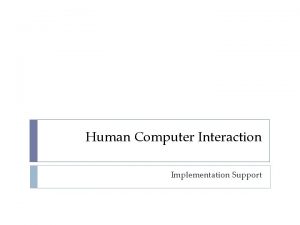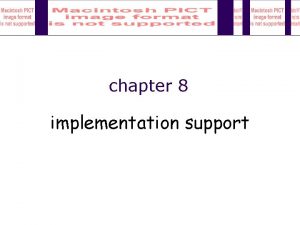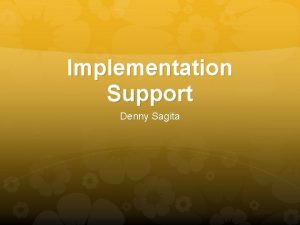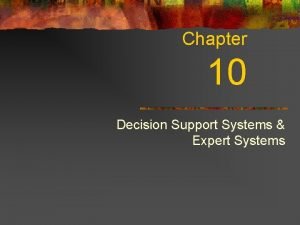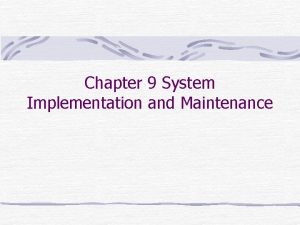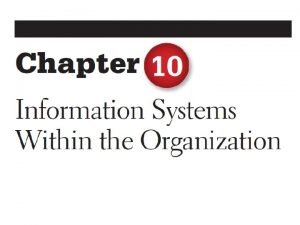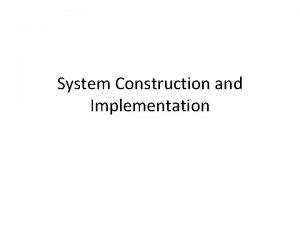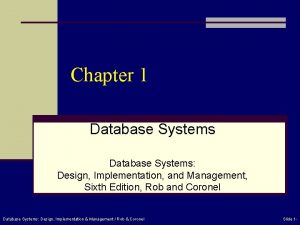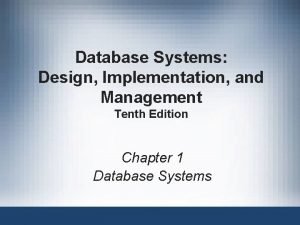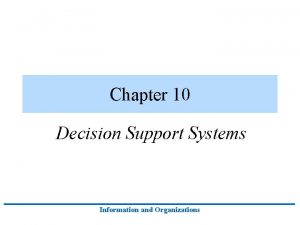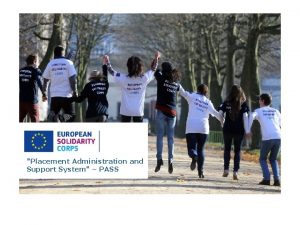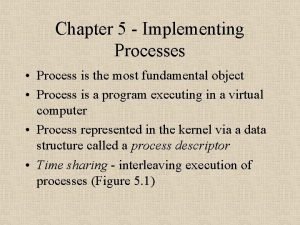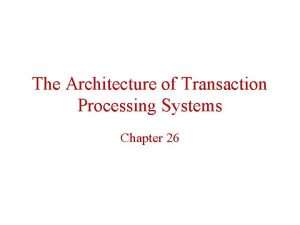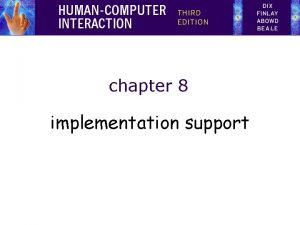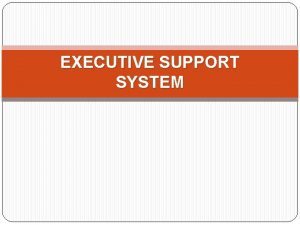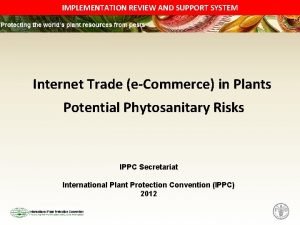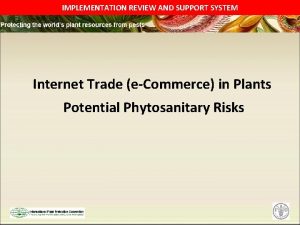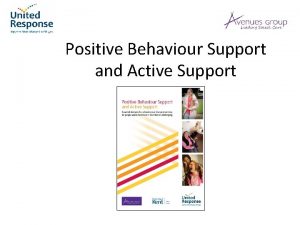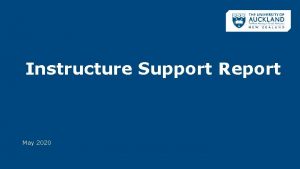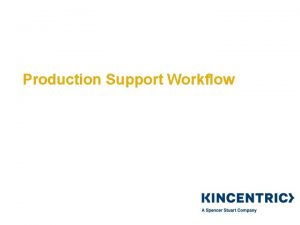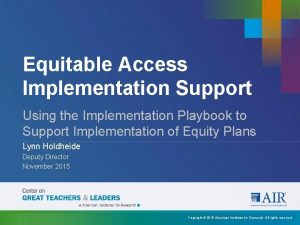IMPLEMENTATION REVIEW AND SUPPORT SYSTEM Implementation Review and
















- Slides: 16

IMPLEMENTATION REVIEW AND SUPPORT SYSTEM Implementation Review and Support System (IRSS) Baseline review of the Implementation of ISPM 6 IPPC Secretariat International Plant Protection Convention (IPPC) 2012

IRSS Background • Foundation activity • Provides countries with the basis for pest listing, determination of status and categorization • ISPM No. 6 Guidelines for Surveillance approved 1997 • Implementation Review and Support System initiated 2011 focuses on ISPM 6 as requested by Standards Committee • Developed in consultation with the Steward, Expert Working Group on Capacity Development and the APPPC

IMPLEMENTATION REVIEW AND SUPPORT SYSTEM Background cont’d • ISPM 6 survey administered to 177 contact points in the 7 FAO regions • 60% response rate - feedback received from 107 countries to -date • Questionnaire also sent to Regional Plant Protection Organizations and shared with staff of FAO • The report doesn’t stop here – global baseline analysis feeds into future capacity building activities • Serves as baseline input for upcoming APPPC ISPM 6 symposium

IRSS Overview • Report presents global analysis of data captured by IRSS ISPM 6 survey – includes regional analysis • Questionnaire derived from 8 major sections of the text of ISPM 6 • Respondents presented priority areas countries wish to see added to revised ISPM 6 • Survey consists of primarily yes/no, multiple choice and open-ended feedback questions • Further to the global analysis, report includes discussions from regional IRSS workshops held in January and February 2012

IRSS Methodology • Qualitative survey administered covering main sections of ISPM 6 • Survey data received from 107 countries • Raw data cleaned -> sorted by section and region -> transformed/coded where possible into numerical representations • Open ended data responses grouped into meaningful patterns/recurrent answers – to maintain individuality/complexity of answers • Dichotomous (Yes/No) and Multiple Choice questions throughout survey

IRSS Methodology • 8 sections of survey cover: – – – – policy and legislative environment organizational structure competencies and culture documented procedures general surveillance specific surveys pest diagnostics resources

IRSS Results Policy and Legislative Environment Salient features • NPPOs are primarily responsible for pest surveillance in the 97% of countries • Surveillance responsibilities of NPPOs not limited to regulated pests but also cover nonregulated pests and regulated pests of national concern in more than 80% of countries • 65% of countries report that besides NPPOs, other agencies (public or private) are also mandated to perform pest surveillance Are there written documents establishing the mandates, functions and responsibilities of those public/private organizations for the conduct of pest surveillance? Yes No No Response 4% 37% 59%

IRSS Results Organizational Structure, competences and culture Salient features • Organizational structure and competency to conduct pest surveillance exist in most countries to provide for engagement of relevant stakeholders • 50% of countries - pest surveillance programs have well developed and compatible data systems to collect, store and report pest information Do pest surveillance programs or services have procedures to review their performance? Yes No No Response 4% 47% 49%

IRSS Results Documented Procedures Salient Features • Computerized retrieval system for surveillance information used by NPPOs in 51% of countries • 45% of countries indicated that their NPPOs have an operational manual for general pest surveillance • Overall disparity exists among countries in the systems for information management Are GIS coordinates used to specify the location of pests detected during pest surveys? Yes No No Response 5% 37% 58%

IRSS Results General Surveillance • Countries compile pest records from more or less the same kinds of sources (NPPO reports, Are databases of plant pest records easily accessible by NPPO's? research organizations, international databases Yes No No Response 4% etc. ) • While 63% of countries indicated that they have national databases of plant pest records, 42% responded that databases are not easily accessible. 42% 54%

IMPLEMENTATION REVIEW AND SUPPORT SYSTEM Results Specific Surveys • Countries generally have more than one organization with authority to decide which crops should be surveyed • In many countries (62%), manuals are indicated to be in existence for specific surveys • The review of performance of surveys conducted according to existing manuals is uncommon as there is limited public and public-private partnerships in specific surveys Are there agreements between NPPO's and industry (or private institutions) to cover expenditures for surveys? Yes No No Response 2% 19% 79%

IRSS Results Pest Diagnostics • 51% of the countries reported that pest diagnostic services are provided by entities other than the NPPO laboratories • Documented procedures for sampling, sample delivery, intermediate storage and disposal are available in 50% of countries • Verification of performance or results from NPPO laboratories with other diagnostic laboratories (inside or outside the country) is carried out in 57% of countries Does the NPPO use virtual diagnostics, i. e. transmission of images of pests to a central diagnostic service inside or outside the country? Yes No No Response 10% 40% 50%

IRSS Results Resources • Highly varying scenarios are presented by countries and regions concerning resources • Results show that pest surveillance is under-funded and not adequately resourced in terms of personnel, and equipment in most countries • Under funding is apparent both within the NPPO budgeting process as well as the lack of support from other public and private agencies, leaving the government as the main sponsor of surveillance activities in the majority of countries

IRSS Results Resources cont’d What is the total annual investment currently being made by the NPPO to conduct Pest Surveillance (USD)? Under 499, 000 USD Over 500, 000 USD No response Estimate the total annual investment (USD) being made by other public or private organizations, agencies or departments (non NPPO) to conduct pest surveillance in the country Under 499, 000 USD Over 500, 000 USD 32% 45% 23% 42% 48% 10%

IRSS Results Resources cont’d Are those human resources sufficient to carry out the activities according to the NPPO's requirements for pest surveillance? How frequent are training programs for staff involved in pest surveillance? No programmed training Not at all Once every 5 years insufficient 4% 7% 7% 12% Once every 3 years With Difficulty 20% Almost 42% 34% Once every 2 years 40% Completely 15% No response 11% 1% 7% At least once per year No response

IRSS Conclusions 1. Country feedback generally indicates an un-coordinated approach to surveillance despite the existence of organizational structures, documented mandates and strategic plans for surveillance 2. Little by way of a clear framework formal liaising between NPPOs and other organizations involved in pest surveillance in regards to surveillance results 3. A common feature in many countries includes inadequate resource allocation and a lack of appropriate technical resources for surveillance 4. The overall situation weakened in most countries by policies, laws and regulations that are not aligned with contemporary global phytosanitary requirements, not explicit on essential actions to support surveillance
 What is user support in hci
What is user support in hci What is major details
What is major details Implementation support
Implementation support Implementation support
Implementation support An expert system is
An expert system is Decision support system and expert system
Decision support system and expert system Decision support and expert systems
Decision support and expert systems System implementation and maintenance
System implementation and maintenance System design implementation and operation
System design implementation and operation A transaction is any business event that generates
A transaction is any business event that generates System construction and implementation
System construction and implementation Database system design implementation and management
Database system design implementation and management Database systems design implementation
Database systems design implementation Decision support system advantages and disadvantages
Decision support system advantages and disadvantages Placement administration and support system
Placement administration and support system Implementation of process in operating system
Implementation of process in operating system A deployment descriptor describes *
A deployment descriptor describes *
